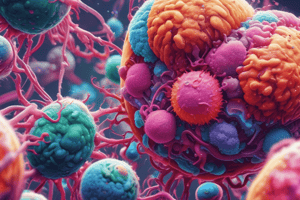Podcast
Questions and Answers
What is the vocabulary term for the ability of a pathogen to cause disease by overcoming the host defenses?
What is the vocabulary term for the ability of a pathogen to cause disease by overcoming the host defenses?
Pathogenicity
Bacteria use ___________ to adhere to host cells.
Bacteria use ___________ to adhere to host cells.
adhesins
Which enzymes are used for penetration by microorganisms?
Which enzymes are used for penetration by microorganisms?
- Collagenase (correct)
- Hyaluronidase (correct)
- Coagulase (correct)
- Kinase (correct)
Endotoxins are only produced by Gram-negative bacteria.
Endotoxins are only produced by Gram-negative bacteria.
Match the following toxins with their corresponding bacterial species:
Match the following toxins with their corresponding bacterial species:
What can endotoxins cause when released into the bloodstream?
What can endotoxins cause when released into the bloodstream?
Flashcards are hidden until you start studying
Study Notes
Mechanisms of Pathogenicity
- Pathogenicity: The ability of a pathogen to cause disease by overcoming the host's defenses.
- Virulence: The degree of pathogenicity.
Portals of Entry and Exit
- Portals of Entry: The routes by which pathogens enter the host, including:
- Mucous membranes (e.g., conjunctiva, respiratory tract, GI tract, genitourinary tract)
- Skin (e.g., through hair follicles and sweat ducts)
- Parenteral route (e.g., trauma, arthropods, injections)
- Portals of Exit: The routes by which pathogens exit the host, including:
- Respiratory tract (e.g., coughing, sneezing)
- Gastrointestinal tract (e.g., feces, saliva)
- Genitourinary tract (e.g., urine, vaginal secretions)
- Skin
- Blood (e.g., through biting arthropods, needles, or syringes)
Adherence
- Adhesins: Surface projections on pathogens that help them adhere to host cells, made of glycoproteins or lipoproteins.
- Adherence mechanisms: Include glycocalyx, fimbriae (pili), and flagella.
- Host cell receptors: Often sugars (e.g., mannose for E. coli).
- Biofilms: Provide attachment and resistance to antimicrobial agents.
Overcoming Host Defenses
- Capsules: Inhibit or prevent phagocytosis.
- Cell wall proteins: Contribute to pathogenicity, e.g., M protein of S. pyogenes.
- Antigenic variation: Avoid immune system recognition, e.g., Trypanosoma and Neisseria.
- Penetration into host cells: Invasins, proteins that cause actin to form a basket that carries the bacteria into the cell, e.g., Salmonella and E. coli.
Enzymes
- Coagulase: Causes blood clot formation, protecting the pathogen from phagocytosis.
- Kinase: Dissolves blood clots, e.g., streptokinase.
- Hyaluronidase: Breaks down "intercellular cement" for tissue penetration.
- Collagenase: Hydrolyzes collagen.
- IgA protease: Destroys IgA.
Toxins
- Exotoxins: Proteins produced by Gram-positive and Gram-negative bacteria, e.g., diphtheria toxin, erythrogenic toxin, botulinum toxin.
- Endotoxins: Lipid A component of LPS in Gram-negative bacteria, e.g., E. coli, Salmonella.
- A-B toxins: Exotoxins with two components, e.g., cholera toxin.
- Membrane-disrupting toxins: Lyse host cells, e.g., leukocidin, hemolysin.
- Superantigens: Stimulate T-cells, causing intense immune response, e.g., staphylococcal enterotoxin.
Pathogenic Properties of Viruses, Fungi, Protozoa, and Helminths
- Viruses: Evasion of immune system by growing inside cells, mimicking Ach, and hiding attachment sites.
- Fungi: Produce waste products that cause symptoms, e.g., ergot toxin, aflatoxin.
- Protozoa: Produce waste products that cause symptoms, avoid host defenses by growing in phagocytes, and undergo antigenic variation.
- Helminths: Interfere with host function, produce metabolic waste that causes symptoms, and avoid host defenses by growing in phagocytes.
Studying That Suits You
Use AI to generate personalized quizzes and flashcards to suit your learning preferences.




